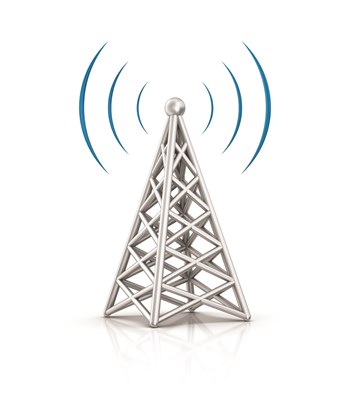
When cable television became widespread in New York City around 1980, it revolutionized the way we watch TV by bringing a dizzying selection of programming to our living rooms. With seemingly endless choices, the terms "couch potato" and "channel surfing" were coined. Today, however, the TV-viewing public has even more choices to make as a result of the 1996 government deregulation of the telecommunications and cable TV markets. As more and more companies enter the market, and technology improves, residents have many new options for internet, telephone and television access. From cable to fiber optics to satellites, telecommunications delivery is moving quickly into the 21st century. This is the time for co-op and condo boards and their residents to become acquainted with their options.
An Evolving Market
In the days before cable, most TVs were wired to a master antenna on the roof of the building, picking up a few local stations. But with cable, a multitude of channels were wired right into the TV, offering perfect reception and more choice. The first cable TV franchises appeared in Manhattan in 1970 through Sterling in Southern Manhattan and Teleprompter in Northern Manhattan. Time Warner was created in 1989 when Warner and Time, Inc. merged. Today there are a total of nine cable franchises in New York City, seven of which are controlled by Time Warner and affiliates covering about one-third of Brooklyn and all of Manhattan, Queens and Staten Island. The other two are controlled by Cablevision in the Bronx and Brooklyn.
The 1996 deregulation of the industry allowed other companies to enter the market, breaking the monopoly held by cable franchise owners. The first company to attack the New York City market in a big way, offering non-franchised cable service, is Residential Communications Network (RCN), based in Princeton, New Jersey. Founded by chairman David McCourt, RCN offers customers all three core services of the multimedia age: cable TV, voice telephony and access to the Internet. Because it has modest overheads, RCN's prices are generally five to ten percent lower than the competition and as much as 30 percent lower if customers choose all three services. As of June 1998, RCN was reported to have barely 719,000 connections, but the firm is aggressively seeking new business in various residential markets from Boston to Washington, D.C. including New York City.
In the past year several other companies have stormed the market, offering TV viewers the satellite option. According to Helen Chee, marketing manager at SkyView, a nationwide provider of digital satellite TV systems with offices in New York City and throughout the country, satellite TV technology has existed in the United States for about 15 years, but the versatile mini-dishes, such as those used by SkyView, came to the market only about five years ago. They accomplish much the same purpose as the huge rotating satellite dish systems that can pick up 300 channels, but are smaller, less expensive and easier to install and maintain. Rather than picking up 300 channels, they offer about half as many, but still far more than cable delivers. SkyView, a division of Ethnic American Broadcasting, a Fort Lee, New Jersey-based firm, has been installing and maintaining digital satellite TV systems for five years. Ethnic American Broadcasting is an acquirer and producer of ethnic programming.
TV Programming Via Satellite
According to Chee, "SkyView can install a single satellite dish on the roof that receives a digital signal from two satellites, offering viewers access to more than 175 channels from DIRECTV and USSB. Our systems, which include a master antenna, also bring in local channels, as well as channels originating in eight foreign languages. So residents now really have more viewing choices available to them than ever before."
There is no upfront installation fee and the monthly subscription price is comparable to Time Warner and other competitors. Like cable television users, satellite TV users are equipped with a box in their apartments. While local stations are not transmitted via satellite—they are picked up by a master antenna on the roof—this behind-the-scenes arrangement is invisible to viewers who can control all programming, including local stations, with their remote controls. "Under the Telecommunications Deregulation Act of 1996, satellite-based broadcasters are not allowed to provide local channels," says Hauser. "The satellite companies get around this by offering a master antenna along with the dish. The local channels come in pretty well."
According to Herb Hauser, president and chief executive officer of Barnes Wentworth, Inc., a Manhattan firm that provides communications network and infrastructure design, installation and project management for residential and commercial buildings, the decision to prevent satellite providers from offering local broadcasts was made in order to level the playing field between the digital satellite TV providers and the land-based cable companies. Cable companies invested billions of dollars on infrastructure in the 1970s and 1980s. "If you could get all the choices, as well as local programming, there would be no reason to choose cable," says Hauser. "Everyone would want digital satellite TV." He points out that another option is to subscribe directly to DIRECTV by going to Radio Shack or any other authorized installer and purchasing a disk for your own use. "This way you can get 530 audio and visual channels," he says. Of course, you need to have access to a rooftop or other outdoor area to install the dish.
The Internet Connection
Until recently, Internet access at home was gained through a telephone modem hooked up to your personal computer. Unless you had a second telephone line installed, you tied up the phone line whenever you went "on line." Now, you can free up your phone line by receiving Internet access from your cable TV provider on the same line that your television is hooked up to. "We offer cable TV services, telephone and high-speed Internet access through a cable modem," explains Jim Maiella, RCN's director of public relations. RCN runs a branch of its existing fiber optic network into the basement of subscriber buildings. According to McCourt, the approach favored by some of his competitors—which is to increase the bandwidth of their copper lines—is not forward-thinking and will only give them one-tenth the capacity of the fiber optic technology he is a proponent of.
Once the wire is in place, each apartment owner can take as many of the services as he wants, or just one. "It's a la carte," explains Maiella. "Basic cable television is just $27.95 a month. RCN offers discounts when more than one service is used, and the more you sign up for, the greater the discount. All our deals are made on a building-by-building basis. There is no minimum number of people who have to sign up, and there's no charge for wiring the building." After the building is wired by a secondary provider such as RCN, the existing wiring for Time Warner remains on the premises and it remains an option for anyone who wishes to subscribe to Time Warner rather than RCN.
Currently, Time Warner offers subscribers only cable television but, according to Robert Jacobs, vice president of public relations, the firm will launch a cable modem product for high-speed Internet access in 1999. Telephone service may also be offered down the road, but no details are available right now. While the basic monthly service, excluding equipment and premium programming, is $31.22, Jacobs points out that Time Warner is an established company with a longstanding reputation for quality service. And New York One, a local news program developed by Time Warner, is not available through satellite or competing cable providers.
Smart Buildings
John Rossi and Damian McShane, marketing segment managers at Bell Atlantic Consumer Marketing, a division of Bell Atlantic Network Services located in Manhattan, have begun meeting with boards to discuss how they can transform their co-ops or condos into "smart" or "intelligent" buildings. They are also spreading the word among developers. With new construction, it makes sense to install an ethernet cable that will provide residents with constant access to a dedicated T1 line. T1, a term that refers to the speed of data transmission, can be provided through fiber optic or copper wiring if it is wide enough. Existing buildings can also become "smart" by installing the same type of network to allow high-speed Internet access.
"In a smart building that has a dedicated T1 line," says Rossi, "There's no more logging on and logging off. You're always on and always connected. The technology allows residents to share the one T1 line and everyone gets much better speed. The flat monthly rate for this service per subscriber would be approximately $70, depending upon the number of units in the building and the number of subscribers."Subscribers are billed individually by the provider. About 50 percent of the units in an 80-unit building would need to subscribe in order to have this service with Bell Atlantic.
DualStar Technologies Corp. in Long Island City delivers local and long distance telephone service, direct broadcast satellite TV service and high speed Internet technology to new and existing buildings. "Since 1996 we have had our trademarked CyberBuilding system running at the newly-constructed Grand Millenium, a 202-unit condo at 66th Street and Broadway," says Robert Birnbach, vice president and chief financial officer. "We now have a total of seven Manhattan buildings outfitted with the CyberBuilding system."
Under this program, "residents have access to traditional and enhanced telephone services, high-speed Internet access via our trademarked Building Area Network, a property web site, direct broadcast satellite TV, home office support, residence door monitoring, building security and surveillance and video teleconferencing," says Birnbach. "One of the things that differentiates us from the competition is our trademarked CyberConcierge, an on-site staff of two to three technical facilitators who help residents use the technology. This service is free of charge."
Residents can subscribe to one or more of these services (or none at all) which are transmitted through the building's infrastructure using a combination of fiber optic and copper wiring as well as coaxial cabling. Residents are billed directly for the services they select. DualStar can strike a deal with the board or the builder/developer to install the service at no cost and then re-coup from the residents who subscribe through their monthly charges. For each of the services, prices are competitive with other providers.
A Painless Process
When the board is impressed by the savings or package offered by a competing telecommunications provider and votes to do business with this firm, not everyone in the building must use the new provider. However, as part of the retrofit agreement—and as a way to keep the costs down—the board may be required by the service company to guarantee a certain number of users. According to Insignia account executive Chris Ryan, six months ago a 165-unit co-op on Third Avenue—that Insignia began managing in June—signed a contract with RCN and approximately 95 percent of the units now get cable through RCN.
"You get all the same channels as Time Warner, except for New York One," says Ryan, who adds that the co-op's management team did not suggest the switch. "Typically, RCN approaches the building and asks if they can give a presentation," explains Ryan. There was no up-front installation fee.
"A lot of people are talking about retrofitting their buildings with Internet capability, but not as many are actually doing it," points out Richard Malpica, a senior account executive at Insignia. However, while Malpica thinks the retrofit market is small, he has noticed that in the last six months more and more companies are positioning themselves to provide these services.
"The people asking for the newest technology now are generally stock brokers and people doing commerce, like the graphic designer who needs to move an electronic file back to his office," says Malpica. "As demographics change, and you find more of these residents in co-ops and condos, we'll see more of a demand for an Internet connection with the office."






Leave a Comment